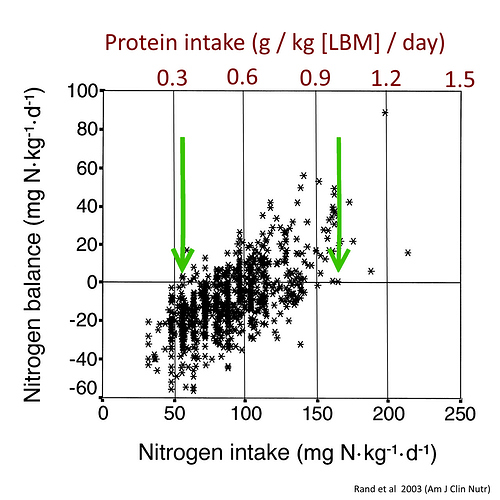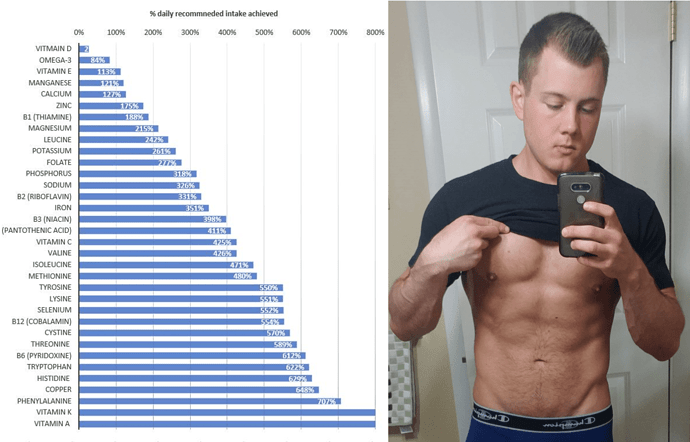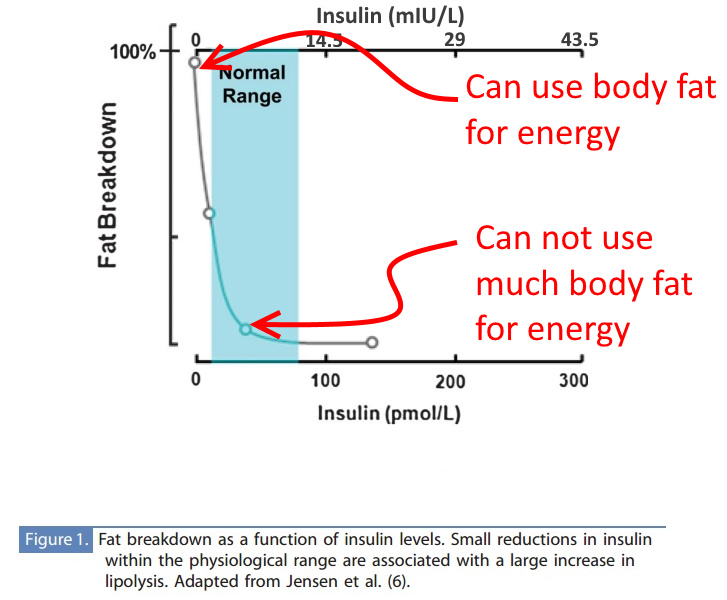Actually my BMR as tested by John Wrights indirect calorimeter is a (to me) impressive 2900 kCal/day. That’s what happens when a hyperinsulinogenic individual eats a low insulinogenic diet to satiety for 4 years. He also measured my RQ at 0.69, so I am locked into using fat for energy.
If I calorie restrict (and the last time I did this was the year BEFORE I went keto - the year I was 150kgs) my BMR drops to almost 800 kCal/day. That’s the range of this particular human’s variability of Calories out (800 - 2900).
Let’s say I’m on a plateau (neither gaining nor losing), and eating 2900 kCal a day, and burning 2900 kCal a day.
Let’s now say that I do a boot camp where I reduce my calories to only enough to get all my essential nutrition (forgetting for the moment that energy is also an essential nutrient) … let’s say I’m only eating protein, some low calorie vegetables, maybe 1200 kCal/day of mostly lean protein (around 300g) and then I’m using the “fat bombs” already on my body for energy. Alright so what actually happens?
Well firstly let’s see how much energy I can draw from body fat every day. I’m at a deficit of 1700 kCal/day, I have 40lbs of body fat, so that’s roughly 140,000 kCal of energy (assuming 1lb of body fat = 3500 kCal). Should be enough right?
Humans have an apparent maximum rate that they can draw energy from adipose tissue (http://blog.2keto.com/alpert-2005/).
To produce all that energy from body fat (assuming no mechanistic inhibitions to using fat for energy) I need to divide that 1700 kCal I need by 31.5 kCal/day/lb adipose tissue to work out how many lbs of body fat I am going to need. So the minimum amount of body fat I will need is around 54 lbs … which is my first problem. I have only 40lbs total of body fat which gives me just 1260 kCal/day.
Assuming I can get so much energy from body fat. There are 2 OTHER rate limits on how fast we can mechanistically turn stored fuel into energy - both are ultimately controlled by insulin. Insulin inhibits how fast we can get fatty acids into our cellular furnaces. But it also determines how fast we can get free fatty acids from body fat in the first place.
My fasted insulin is currently around 17 mIU/L. That’s a snapshot of where my insulin is when I eat nothing. When I eat 300g of protein across 3 sittings you can bet it will peak higher 3 times, and as a hypoerinsulinaemic it stays up for up to 6 hours after any peak - so I’d be at a higher level chronically. This chart which I got from a presentation by Ted Naiman shows the problem with how insulin affects access to body fat.
And you might say well if that chart was correct then no-one with high insulin could fast. You have to look at the actual data for that study where they did a second chart for diabetics (in black dots) vs non-diabetics (white dots)
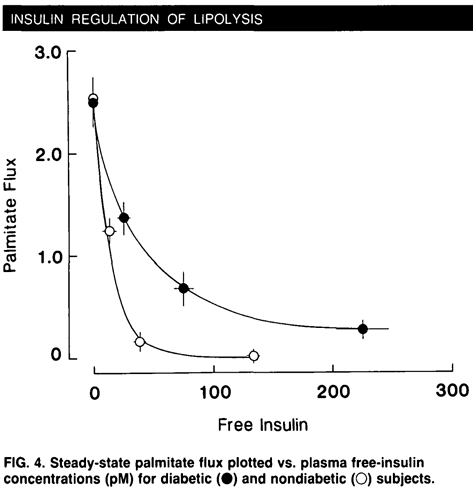
And you can see that the inhibition is not as tight for diabetics, but the chart is still pretty much all asymptote - the less insulin you make the more fat you can get access to. Even assuming I get the chronic high insulin “free pass”, at roughly 100 pMol/l I am sitting on just 25% of maximal energy release from adipose. 25% of 1260 kCal = roughly 400 kCal a day from my fat bombs (assuming the maximal release of FFE given my fasting insulin).
So what happens if I do one of these PSMF boot camps? My body is used to getting 2900 kCal/day from diet, it’s getting 1200/day from diet and 400 kcal/day from storage. The math isn’t working out well is it?
So 2 things the body will do when faced with a budgetary crisis like this. We know one.
We’ve seen it already. It will reduce MBR, cancel all energy processes not essential for immediate survival. Your body will attempt to survive the apparent famine. I’d need to go from 2900 kCal/day to 1600 kCal/day overnight. It takes weeks normally for metabolic rate to drop that much, so in the meantime the body HAS to find a source of energy.
And that brings us to the bodies backup strategy for when it’s primary energy sources are constrained. Burning the furniture. We can use some amino acids for energy directly and indirectly, and most healthy humans have an excess capacity of that stored in muscles. So to make up a deficit of 1300 kCal, I will need roughly 325g of protein, roughly a kilo of muscle a day.
What? You can eat 300g of mostly protein a day and still lose 1kg of muscle weight a day. Yes, if you are doing something reckless like burning protein for energy.
And then of course I’d have the ammonia accumulation issue as now I would be deaminating 625g of protein a day (more than half from my own body).
So what if I wasn’t hyperinsulinamic, let’s say I could drop insulin when I fast to 2 mIU/l. I’m eating 1200 kCal, I’m now able to use 1260 kCal/day from my 40lbs of body fat, I’m still at a deficit of 440 kCal, that’s just 110g of protein, around 1/3rd of a kilo of muscle weight. It’s still bad but not quite AS bad. Either way your metabolic rate needs to drop to try to protect your lean tissue.
Over time you adjust to using less energy, and then your body will eventually out compete your ability to calorie restrict and the weight will go back on … but unless you are working out 1.5 hours a day doing weight bearing exercises to desperately hold onto your gains you will likely end up on the upswing of the yo-yo with a higher body fat %.
Or you can keep calm and keto on, and trust your body to determine the optimum ratio of fat to lean for your specific context - which could be sedentary, or lifting heavy 4x a week, or it could be 100s of kms a week on the bike, it could be high insulin, or low insulin, or elevated but slowly reducing insulin.

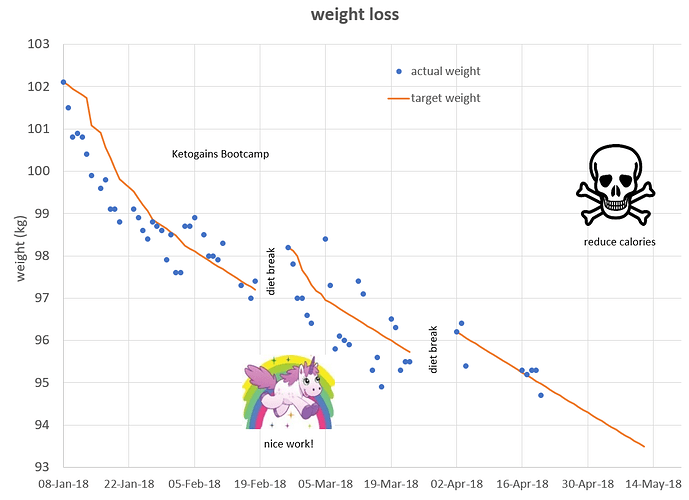

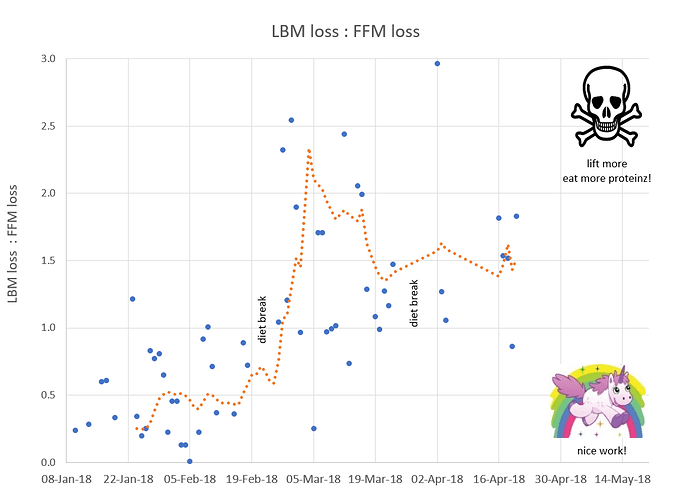

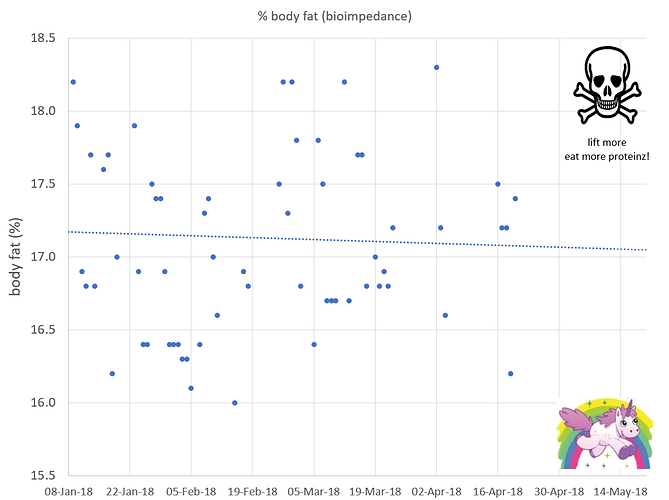
 . This data is the best we can do so as long as it’s interpreted with relevant caveats, it offers strong insights (as you know better than I) e.g. the value of exercise for your LBM/MM.
. This data is the best we can do so as long as it’s interpreted with relevant caveats, it offers strong insights (as you know better than I) e.g. the value of exercise for your LBM/MM.